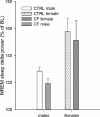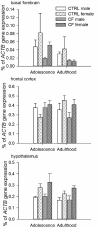Sleep and Behavior in Cross-Fostering Rats: Developmental and Sex Aspects
- PMID: 27634786
- PMCID: PMC5103809
- DOI: 10.5665/sleep.6328
Sleep and Behavior in Cross-Fostering Rats: Developmental and Sex Aspects
Abstract
Study objective: Adverse early-life events induce behavioral psychopathologies and sleep changes in adulthood. In order to understand the molecular level mechanisms by which the maltreatment modifies sleep, valid animal models are needed. Changing pups between mothers at early age (cross-fostering) may satisfyingly model adverse events in human childhood.
Methods: Cross-fostering (CF) was used to model mild early-life stress in male and female Wistar rats. Behavior and BDNF gene expression in the basal forebrain (BF), cortex, and hypothalamus were assessed during adolescence and adulthood. Spontaneous sleep, sleep homeostasis, and BF extracellular adenosine levels were assessed in adulthood.
Results: CF rats demonstrated increased number of REM sleep onsets in light and dark periods of the day. Total REM and NREM sleep duration was also increased during the light period. While sleep homeostasis was not severely affected, basal level of adenosine in the BF of both male and female CF rats was lower than in controls. CF did not lead to considerable changes in behavior.
Conclusions: Even when the consequences of adverse early-life events are not observed in tests for anxiety and depression, they leave a molecular mark in the brain, which can act as a vulnerability factor for psychopathologies in later life. Sleep is a sensitive indicator for even mild early-life stress.
Keywords: BDNF; adenosine; cross-fostering; depression; sleep homeostasis.
© 2016 Associated Professional Sleep Societies, LLC.
Figures






References
-
- Arnow BA. Relationships between childhood maltreatment, adult health and psychiatric outcomes, and medical utilization. J Clin Psychiat. 2004;65:10–5. - PubMed
-
- Heim C, Nemeroff CB. The role of childhood trauma in the neurobiology of mood and anxiety disorders: preclinical and clinical studies. Biol Psychiatry. 2001;49:1023–39. - PubMed
-
- McCormick CM, Smith C, Mathews IZ. Effects of chronic social stress in adolescence on anxiety and neuroendocrine response to mild stress in male and female rats. Behav Brain Res. 2008;187:228–38. - PubMed
-
- Chapman DP, Wheaton AG, Anda RF, et al. Adverse childhood experiences and sleep disturbances in adults. Sleep Med. 2011;12:773–9. - PubMed
MeSH terms
Substances
LinkOut - more resources
Full Text Sources
Other Literature Sources
Medical
Miscellaneous

